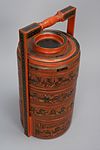Tiffin Box
About this object
History of use
Tiffin boxes are associated with the idea of taking a light lunch, a custom introduced into India by the British during the nineteenth century. Today, tiffin boxes can be found in many parts of Asia and though they continue to be used primarily as food carriers, they have also become an important art form.
Iconographic meaning
The tiers are separated by the parallel, concentric lines characteristic of the yun border decoration. Yun is a unique style of incised lacquer-ware decoration, one of the major artistic traditions of Burma. Palace scenes from the Mandalay Court, nandwin, are repetitively depicted on the tiers in a rhythmically lively manner.
Physical description
Round, five-tiered stacking box with elaborate scenes painted in red, yellow, green and black on the sides. The bottom compartment (part a) has two vertical slats attached at opposite sides; the tops of the slats are joined by a thick horizontal handle with a decorative, rounded centre. Stacked on top of the bottom compartment are three more compartments of similar construction (parts d-f); a round red tray (part c) fits into the top compartment. The lid (part b) has a raised circular handle and is covered with concentric bands of red, yellow and black patterning.
